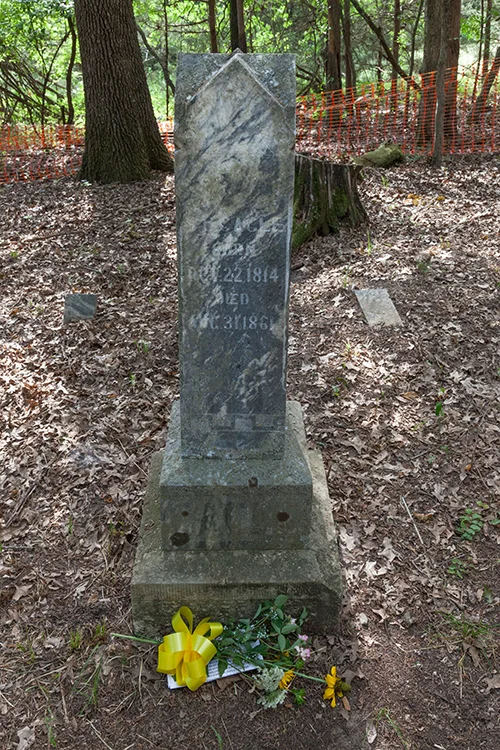This post continues the story of the decoration of the graves with the letters written to Charity & Louisa Bonham. (If you haven’t read the previous “Letters to the Departed” posts, Ginger and I conducted a ritual in early June of decorating each grave with a wildflower bouquet and a letter expressing what we might say to the recipient if we could.)
The Bonham graves date from Dec, 1865, some fours years and a few months after Susan Cagle was laid to rest. Since we do not know the dates of the deaths of several of the Cagle family members, we cannot say whether the two burial sites were active at the same time or what their relationship, if any, was to one another.
Charity,
Your history is hard to piece together. Your tombstone declares you to be the wife of David Bonham. You lie next to the little daughter of John Bonham, the son of a David and Saletha Bonham. I do not know when Saletha Bonham died, though I do see evidence of her being alive in 1860. I take you to be David’s 2nd wife, much his junior, as your step-son appears to be only about 5 years younger than you. I cannot tell how long you and David were married, I cannot find any record of David’s death, and I can find no evidence of children borne by you. Your marriage might have been a short one, yet clearly at your death you were living with or nearby your step-son, his wife, and his children. You were carried away just before Christmas in 1865.
How did you come to be buried so close to the Cagle family plot, already well established, and yet separate from it? Perhaps at that time each family kept a burial plot on their land, rather than the community collectively setting aside a location for a shared cemetery. Perhaps the Cagle plot was somewhat abandoned - both Martin and Susan Cagle had died, the boys perhaps lost, and Mary, nearing womanhood, might have been living elsewhere with Frances and her husband. It seems unlikely that the Wilks had yet arrived in the area at the time of your death.
How is it that, of all the Bonhams, only you and little Louisa lie here? I will have to let the mystery be. Rest well.
Louisa,
It appears that your parents and older siblings migrated to Texas from Arkansas sometime after May of 1862. I am basing that on the record of the birth of your sister, Charity, in Arkansas in 1862, and the record of your birth in Texas in 1864, though your brother John’s obituary states that he came to Texas with his parents in 1865. If that is the more accurate date, then you made that trip from Arkansas with your family.
You were a bright toddler approaching your 2nd birthday when you left this earth on Jan. 4, 1866, and were laid to rest next to your grandmother, who had died only two weeks before you. There could have been no joy for your family in this holiday season. I have been told an old story of your family passing through and leaving the graves there in the woods in their wake as they moved on, but this seems unlikely. I see much evidence of your parents and siblings in the annuals of Fannin County for years to come. I have even found a photograph of your brother, John, as an old man. However, you and Charity do lie here alone, so perhaps there is some kernel of truth in the old story - your family did not put down roots here, even if they did so elsewhere in the County.
I am told that the two of you will be moved to a Bonham family plot in the Willow Wild Cemetery. You will be in the bosom of family at last, though I might have wished that you were to be placed in Smyrna with your parents. It is lovely there, and Willow Wild seems such a big and bustling place compared to your intimate place here among the trees. May your dreams be sweet wherever you lie.
Bonham Family Gravesite, photo by Wanda Holmes Oliver.
Lovely Basket Ginger Made to Honor Charity & Louisa, photo by Wanda Holmes Oliver.
Story by Wanda Holmes Oliver.






